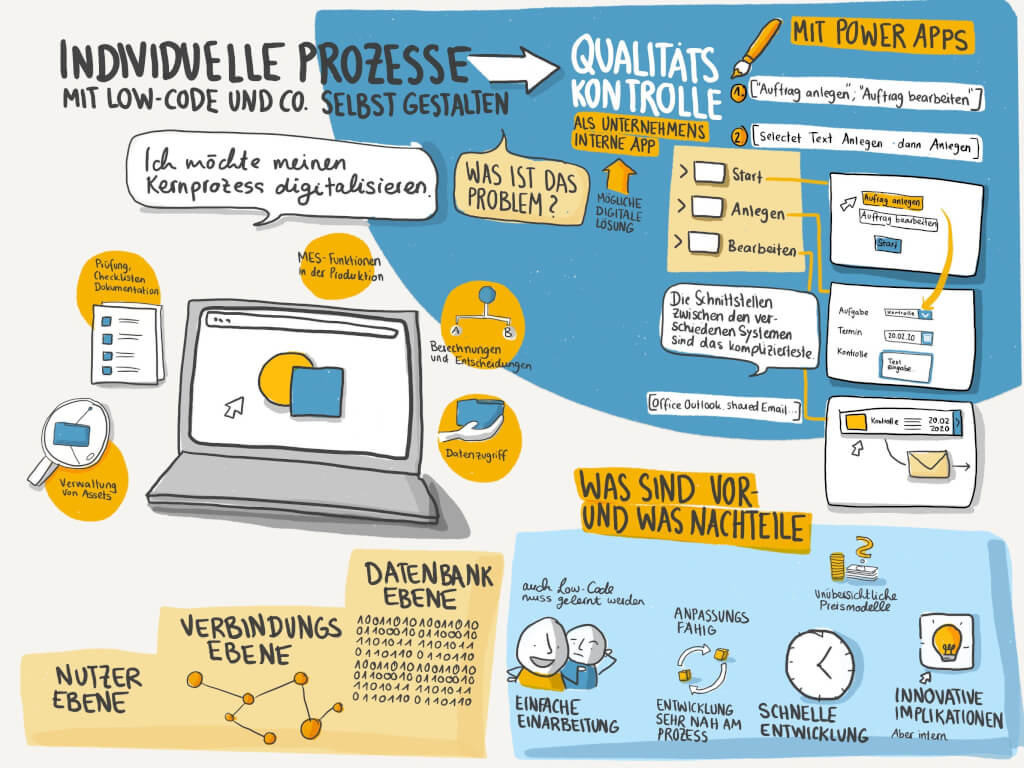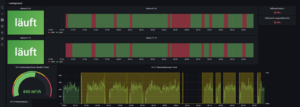"We have succeeded in designing our own business applications for important company processes. The developed low-code apps run more reliably, faster and hand in hand with the physical processes. Our employees have less effort and our customers benefit from being closely involved in the processes of our departments. Those responsible for the process were directly involved in the development process and were able to anchor their specialist knowledge in the application."
Project manager of our customer tweet
Sounds good, but do you think you'll ever use those words to rate a software project?
If not, that's understandable. Classic software projects are often complex and lengthy and thus present SMEs and craft businesses with major challenges. Typically, these companies do not have full-fledged development departments and there is usually no need to build up IT know-how internally. Difficulties in software projects arise as a result of this both in system implementations and in individual projects. Already during the development and communication of goals and requirements, it happens that process managers, consultants and programmers speak different languages. These imponderables then drag on until the implementation of the solution, which is often successful nonetheless, makes the way there expensive and time-consuming.
Low-code platforms promise to remedy this problem by greatly simplifying the development of software solutions. Visual development environments play a central role here, in which the user links ready-made components to their own solutions and, if necessary, adds missing functions via programmed modules.
Problem solver low code
The low-code approach solves the following problems of classic development:
- development costs: Development costs can be reduced by up to 70% through low-code applications. Although this number comes from a study by a low-code provider, it has also been confirmed in our customer projects that projects can be implemented much more cheaply.
- development time: A cost factor, but also another important evaluation criterion with regard to the feasibility of projects is the development time, which can be significantly reduced by low-code platforms. This reduction in time makes it possible to quickly convert ideas into prototypes that are helpful for further assessment of the project and verify the added value. This is also the case when carrying out internal or external consulting projects, where ideas can be presented within hours to a few days. The time required to implement the operationally applicable solution can also be significantly reduced compared to classic projects.
- Integration of own solutions: Especially in SMEs and in the trades, small solutions have emerged, eg on the basis of Excel, in the form of paper lists and by email rules. However, the large number of these decentralized little helpers leads to a complex structure within the company and thus to unclear responsibilities that are difficult to understand on the one hand and difficult to manage on the other hand in the long term. Low-code apps offer the possibility of effectively digitizing even these small solutions and linking them in a structured way. This creates, for example, clear information, documentation and release processes and apps for management, production or service. Thus, the employees can concentrate on their essential tasks and administrative and coordination effort is eliminated.
- Integration of existing systems: Open interfaces and connectors allow the connection of a large number of services, data sources and inventory systems to the low-code solution (e.g. ERP, CMS, WMS, MES, ...). Based on the existing data and information flows, useful extensions for optimizing business processes can be created.
- default building blocks: Many problems are solved over and over again in the course of software development. Why reinvent the wheel? Low-code platforms provide many of the required building blocks that can be freely combined with one another. At the same time, the solutions can be used across platforms as a web application, on tablets and smartphones, so that there is no development effort here either.
- Internal key users: The visual programming environment is much easier to learn than traditional development, so that internal key users can be trained. On the one hand, they have a high level of process understanding and, on the other hand, these users can develop or configure new ideas in the low-code environment without having to hire an external company. Even when the solution is developed by external contractors, it makes sense to involve the internal process managers closely in the development process in order to use their expertise. The speed of development also enables close coordination appointments parallel to development, in which project progress is coordinated and planning is adjusted.
The providers of the low-code platforms are constantly developing the portfolio of low-code components, so that there is a range of extensions that can be used in the apps. These should only be mentioned briefly at this point, in the future I will deal with one or the other topic in detail in this blog:
- Artificial intelligence, especially in the field of image analysis.
- Augmented Reality, especially for mobile apps.
- (Automatic and intelligent) chat bots
- Portals for communicating information from within the company
- Tests to verify the business logic and functionality of the solution
- UI flows to automate processes
Low-code platform issues
A number of advantages of low-code platforms have been described previously, but there are also points that should be considered before deciding on such a solution:
- Shadow IT and scattered applications: If a large number of process managers are empowered to develop their own solutions, this can generally happen "silently". This results in similar problems as today when developing your own solutions, eg on the basis of Excel. It should therefore be ensured that developments are communicated and coordinated so that a transparent process is created. A joint decision should be made as to which developments should be pushed forward and how different projects should be coordinated.
- Confusing pricing models: The price models of the providers are mostly very confusing and the license costs for the basic system are very high for some providers. From our point of view, this makes it difficult to get started, especially for SMEs and craft companies, since the platform has to be tested at the beginning and checked for applicability in the company.
- training effort: Low-code programming must also be learned. Even if the hurdles for learning the programming environment are much lower than with classic programming languages, time must still be invested in further training in this area. "Low" also means that it makes sense to supplement the application with individual programming in a few places.
- Internal applications: Some of the available platforms are mainly suitable for the development of internal applications that can only be used in the company and to which customers and suppliers cannot have access. In this area, however, there are some efforts that would allow the systems to be opened up to the outside world.
- Proprietary Systems: Switching between two low-code platforms is not possible without major effort, since the environments are based on different technologies. As with any software purchase, companies should therefore evaluate the resulting lock-in effects.
Identify appropriate processes
Standard processes in the company should be covered with standard solutions that have open interfaces. For individual core processes, on the other hand, solutions should be developed that support the company's capabilities in the best possible way and that can grow and be flexibly adapted as the core processes change. The following figure roughly classifies a selection of tasks in the company:

In the area of individual core processes, it is worth checking whether the individual software solution based on a low-code platform is a sensible option compared to classic individual development.
Eight typical fields of application
- Checklists, tests, documentation
- Asset Management
- MES functions in production
- Data access and dashboards at operational and management level
- Provision of information (internal and towards the customer)
- Individual calculations and decision-making aids in the process
- Replacement for spreadsheet tools
- approval processes
low-code platforms
There are a variety of platforms that offer low-code solutions. The illustration of the Magic Quadrant of Gardener gives a comprehensive overview.
In particular, the providers from the "Leader" quadrant offer promising platforms, although these differ significantly in terms of functionality, range of functions and price model. On the companies' websites you will find a large number of use cases from which you can draw inspiration. You will find one of our use cases for individual production data acquisition in production here.
SWMS has already gained experience with the solutions from Microsoft (Power Platform) and Siemens (Mendix).
Conclusion
Low code platforms and the resulting solutions can help to provide the best possible support for business processes and individual core processes in SMEs and handicraft companies and offer the possibility of using existing data in the company and creating new offers for internal and external customers.
Despite the simplicity and speed with which your solutions can be developed. Do not ignore important development components apart from the pure programming work, such as the requirements analysis, an evaluation of the solution approach, a comparison of the available technologies as well as training and coordination dates. The design and the interaction of the user with the solution should also be considered in the project. It is precisely these building blocks that are crucial for successful project implementation, as they contribute to the creation of a sustainable system architecture that suits your use case. Subsequent adjustments and extensions are thus made possible.
In summary, a graphic recording of a lecture in which we spoke at the event "Digitization practice forum“ 2020 in Oldenburg on the topic of Low Code with Microsoft Power Apps. At this point many thanks to Paula Foehr for the great visualization:

Do you already have an idea of how to use low-code solutions in your company? We look forward to your feedback and your experiences. Contact us with your ideas, we will be happy to give you a non-binding assessment of feasibility, requirements and the necessary steps for your project. You can reach Joshua Coordes via [email protected].



